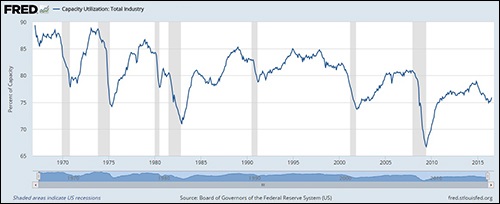By Pam Martens and Russ Martens: August 18, 2016
Since the Wall Street crash in 2008 crippled the U.S. economy, Congress has played the role of a spectator at a big league baseball game – munching on popcorn and licking its greasy fingers soiled with corporate campaign loot – as the real players on the field, the Federal Reserve, controlled the action.
The above chart shows the steady erosion of Capacity Utilization in the U.S. since Congress surrendered its job to the deeply conflicted Fed. The chart comes courtesy of the Federal Reserve Bank of St. Louis, which defines Total Industry Capacity Utilization this way:
“the percentage of resources used by corporations and factories to produce goods in manufacturing, mining, and electric and gas utilities for all facilities located in the United States (excluding those in U.S. territories).”
In November 2007, prior to the onset of the crash, Capacity Utilization stood at 80.9 percent. Last month it clocked in at 75.9 percent. It has been on a sharp decline since November 2014.
The St. Louis Fed says you can also think of capacity utilization as how much capacity is being used from the total available to produce the demand for finished products. Clearly, in a nation where wealth and income is concentrated in the hands of one percent of the population, there will be withering demand for products and an intractable cycle of deteriorating capacity utilization. In other words, the problem is wealth and income inequality, which is being exacerbated rather than helped by allowing the Federal Reserve to remain in charge.
The Fed’s enforcement of zero to near-zero interest rates has stripped income from seniors living on fixed income while inflating financial assets – the vast majority of which are held by the super rich. While the Fed claims to have made great strides on the employment front, government data show a serious problem. According to the Bureau of Labor Statistics, in January 2007, 91.5 percent of men aged 25 to 54 were gainfully employed in the U.S. Today, that number stands at 88.4 percent. There has been no material improvement in that number for a solid five years of this so-called “recovery” managed by the Fed.
Today, Bloomberg View has put a human face on how Fed policies have failed the average American. It shows a photograph of a young homeless man, his consumptive capacity neatly contained in a shopping cart huddled close to his park bench bedroom, as he potentially dreams about his future under an American flag themed blanket. The column also questions the Fed’s success, taking a hard look from another angle – GDP on a per capita basis.
The underemployment of working age men is more consistent with an economic depression or deep recession than with an economic recovery. Consider what First Lady Eleanor Roosevelt wrote in her popular “My Day” column on September 23, 1937, during the Great Depression:
“I am increasingly conscious of the plight in which men and women over forty who need work are finding themselves. Quite frequently there are letters in the mail asking my advice as to what they can do. Someone told me yesterday of one occupation in which a man over forty was actually preferred to anyone younger and I heaved a sigh of relief. It seems to me ludicrous that this situation should exist for at forty a man or woman should be at their best and have experience and poise and patience all of which should make meeting certain problems of work easier. Today in my mail I find a gentleman who suggests that it might be well to dramatize this situation on the radio and I rather hope he carries out his ideas for people should give it more consideration.”
Indeed, Congress should have found some time during the past eight years to give this “more consideration.” Instead, Congress has relied on the serially misguided Fed to do its job for it. Take a look at the timeline of pronouncements from the Fed in its FOMC policy statements:
December 16, 2008: “The Federal Reserve will employ all available tools to promote the resumption of sustainable economic growth…The focus of the Committee’s policy going forward will be to support the functioning of financial markets and stimulate the economy through open market operations and other measures that sustain the size of the Federal Reserve’s balance sheet at a high level.”
January 26, 2011: “Although the Committee anticipates a gradual return to higher levels of resource utilization in a context of price stability, progress toward its objectives has been disappointingly slow.”
January 30, 2013: “To support a stronger economic recovery…the Committee will continue purchasing additional agency mortgage-backed securities at a pace of $40 billion per month and longer-term Treasury securities at a pace of $45 billion per month.”
January 28, 2015: “On balance, a range of labor market indicators suggests that underutilization of labor resources continues to diminish.”
Since the crash, the Federal debt has doubled to $19.4 trillion. The balance sheet of the Fed has more than quadrupled from its binge into sopping up Wall Street’s excess capacity (Quantitative Easing), exploding from $800 billion to $4.5 trillion.
It’s long past the time for Congress to wash off those greasy fingers and do its job.


